When I sit on our first floor apartment porch, I often look out at our small patch of unmowed vegetation growing at the edge of the forest border. We are the only tenants lucky enough to have this “unkempt” natural space, all due to a metal pipe sticking out of the ground barring any lawn mower from plowing through. Earlier this spring, I cut back some invasive mugwort to give native plants a chance to grow. Now, I am enjoying views of four-foot-tall Canada and grass-leaved goldenrod, speckles of amber gems from blooming jewelweed, and patches of prehistoric sensitive fern.
You’re enjoying a feature piece as part of a MercerMe series in partnership with Friends of Hopewell Valley Open Space (FoHVOS). This article was written by FoHVOS land steward, Kaitlin Muccio.
My little meadow may not have the most extraordinary assortment of species, but it still remains an important sanctuary for wildlife. In my zealous pulling of mugwort, I discovered in the leaf litter a cloudy-eyed garter snake about to begin its shed, along with a petite Dekay’s brown snake quizzically flicking its tongue at me. The native plants now able to bloom will also support a great diversity of pollinators.
We all have an opportunity to restore some part of our lawnscape, no matter how small, into native habitat. A native wildflower meadow is a great place to start. Unlike a monoculture of mowed grass, meadows are low-maintenance, drought tolerant, provide habitat for wildlife and showcase a beautiful kaleidoscope of flowers. Below is an introduction to three fantastic wildflowers that can be a part of your meadow.


Milkweed Medley
A favorite among humans and pollinators, milkweed truly needs no introduction. From the genus Asclepias, milkweeds are named for the milky white sap that oozes from broken stems and leaves. This milky substance is unpalatable to herbivores, making milkweed deer-resistant!
Conspicuous, bright, and beautiful, milkweed is an important plant to a swath of pollinators. The plant is a larval host to grey hairstreaks, monarchs and queen butterflies and is frequented by many species of bees. Did you know there are three species of milkweed to choose from? Common milkweed (A. syricia) has delicate pale pink flowers and is widespread in our meadows. If you’re looking for something a bit more flashy, the brilliant orange blooms of butterfly milkweed (A. tuberosa) is for you. If you have a wetter meadow, swamp milkweed (A. incarnata) thrives in moist soils and adorns deep, bright pink flowers.
A Minty Alternative
Many gardeners have witnessed how quickly culinary mint (genus Mentha) can overtake a garden, sneakily spreading via underground rhizomes. A great native alternative with less aggressive growth habits is mountain mint, (genus Pycnanthemum). Rubbing the leaves between two fingers, or even walking through a patch, will emit the familiar aroma of spearmint. While we enjoy the minty scent, herbivores tend to avoid it, making mountain mint deer resistant!
While the densely packed clusters of petite pale pinkish white flowers may not be exceptionally showy, this plant will catch your attention with its foliage. The top leaves near the flower cluster have a delicate, powdery silver coating. This almost snowy look beautifully contrasts with the typical green foliage of other plants, offering a unique look to your meadow.

Not Quite a Sunflower, but Just as Sunny!
A sunflower is the ultimate symbol of summer. With nearly 20 species native to New Jersey, there are certainly plenty to choose from. Interestingly, there are many look-a-like species that are not real sunflowers! Known as false sunflowers and part of the Heliopsis genus, these flowers are just as bright and sunny as true sunflowers and are still a great native choice for your meadow. The only difference is that the rays, or showy yellow petals, of false sunflowers do not fall off while they do fall off in the case of true sunflowers. (Caption for feature photo: Heliopsis species can grow anywhere from 3’-5’.)
Enjoying this? Don’t forget to check out Trail Guide with Jenn Rogers: Exploring Fiddler’s Creek Preserve

All the species shown here are currently in bloom within the restoration meadows at Baldpate Mountain. I encourage you to take a trip out to see them and the many other native flowers and grasses. Take a moment to watch a monarch drink from a milkweed or a bumblebee dance upon a false sunflower. Hopefully you’ll gain some inspiration for what your wildflower meadow can blossom into.
If you are interested in growing a native meadow, FoHVOS provides guidance and support for Hopewell Valley residents through our Residential Community Conservation program. Visit our website to learn more.
About Kaitlin Muccio: Originally from northern New Jersey, and now living in Princeton, Kaitlin has always had a passion for wildlife. She received her B.A. in Animal Behavior from Franklin and Marshall College in Lancaster, PA, and recently completed her M.S. in Global Change Biology from Tufts University where she focused on bird conservation, endocrinology and invasion ecology. Kaitlin has extensive experience conducting rare plant surveys, radio telemetry, songbird banding along with various other projects in both the nonprofit and conservation sector. She is excited to support FoHVOS through research and monitoring of rare species and stewarding critical habitat in her home state.







